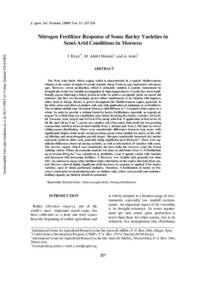Nitrogen Fertilizer Response of Some Barley Varieties in Semi-Arid Conditions in Morocco

Authors:
The West Asia-North Africa region, which is characterized by a typical Mediterranean climate, is the center of origin of cereals, notably wheat (Triticum spp.) and barley (Hordeum spp). However, cereal production, which is primarily rainfed, is mainly constrained by drought due to the low rainfall accompanied by high temperatures. Cereals have been traditionally grown following a fallow period in order to achieve acceptable yields on stored soil moisture, but they are increasingly grown either continuously or in rotation with legumes, either food or forage. Barley is grown throughout the Mediterranean region, generally in the drier zones and often on shallow soils and with application of minimum or no fertilizers. The medium-rainfall zone of central Morocco (200-500 mm yr(-1)) is typical of the region as a whole. In order to provide a rational basis for barley fertilization, especially as regards nitrogen (N), a field trial was established near Settat, involving five barley varieties (ACSAD-60, Tessaout, Asni, Arig-8, and ACSAD-176), along with four N application at four levels (0, 40, 80, and 120 kg N ha(-1)), grown on a shallow soil (Petrocalcic Palexeroll) for two growing seasons that varied in terms of total rainfall (Year 1, 261mm and Year 2, 302 mm) as well as within-season distribution. There were considerable differences between crop years, with significantly higher yields in the second growing season when rainfall was heavy at the critical tillering and stem-elongation growth stages. Nitrogen consistently increased dry matter and grain yields in either year, generally being significant up to 80 kg ha(-1). There were significant differences observed among varieties, as well as interactions of varieties with years. The six-row variety Arig-8 was consistently the best while the two-row Asni, the lowest yielding variety. Where an economic analysis was done on yield data (Year 1), N fertilization up to at least 80 kg ha(-1) was considered as profitable. Crop N uptake varied with varieties and increased with increasing fertilizer. N Recovery was variable and generally less than 50%. In contrast to many other fertilizer trials with barley in the region, this trial from central Morocco showed highly significant yield increases in response to applied N for barley varieties, most of which performed similarly. Therefore, N fertilization of barley in Morocco's semi-arid cereal-producing zone on shallow soils, where root growth and moisture-holding capacity are limited, should be promoted.
